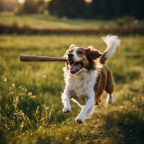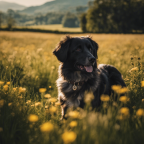Click and GO TO THE BEST DOG NAME GENERATOR HERE
You know that feeling when you’re playing fetch with your furry friend, and they just won’t let go of the toy? It can be frustrating, right?
Well, fear not, because we have the solution for you. In this article, we will delve into the world of Italian dog commands and explore the power of ‘Rilascia’ – the ultimate release command.
Get ready to unlock a whole new level of obedience and communication with your canine companion.
Key Takeaways
- Reinforce ‘Rilascia’ command for timely release
- Use positive reinforcement to train dogs to release objects
- Avoid force or punishment when dogs become possessive
- Practice ‘Rilascia’ command in different environments for consistency
The Importance of ‘Rilascia’ in Dog Training
You should always reinforce the ‘Rilascia’ command when training your dog to ensure their timely release. Positive reinforcement plays a crucial role in dog training, and ‘Rilascia’ is no exception. By rewarding your dog for releasing an object or letting go of something, you’re reinforcing the desired behavior and encouraging them to repeat it in the future. This positive association creates a strong connection between the command and the action, making it easier for your dog to understand and obey.
However, teaching ‘Rilascia’ can sometimes present challenges. One common hurdle is when dogs become possessive of objects and refuse to release them. In such cases, it’s important to remain patient and avoid using force or punishment. Instead, try using high-value treats or toys as a trade-off to motivate your dog to let go of the object willingly. Gradually decrease the value of the reward over time to ensure that your dog associates the command with the action itself, rather than just the reward.
Another challenge is when dogs release the object but immediately pick it up again. To address this, you can practice the ‘Rilascia’ command in a controlled environment, using a leash or a long line to prevent your dog from re-engaging with the object. With consistent training and practice, your dog will learn to release the object and remain in a relaxed state until given permission to engage again.
Understanding the ‘Rilascia’ Command
If your dog struggles with understanding the ‘Rilascia’ command, try using treats and toys as incentives to reinforce the behavior. ‘Rilascia’ is an Italian command that translates to "release" in English. The word comes from the Italian verb ‘rilasciare’, which means to let go or to free. It is commonly used in dog training to teach dogs to let go of objects or to release their grip on something. However, it is important to note that the interpretation of the command can vary in different regions.
In some regions, ‘rilascia’ is used specifically to teach dogs to release objects from their mouth. In other regions, it may be more broadly interpreted to mean letting go of any object or even to stop a certain behavior. This variation in interpretation can lead to confusion for dogs and their owners if they are not aware of the regional differences.
To effectively teach your dog the ‘Rilascia’ command, it is important to be consistent in your training methods and use positive reinforcement. Here are some tips for teaching ‘Rilascia’ to your dog:
| Tips for Teaching ‘Rilascia’ |
|---|
| Use treats and toys as incentives |
| Be patient and consistent |
| Practice in different environments |
Tips for Teaching ‘Rilascia’ to Your Dog
Try using treats and toys as incentives to reinforce the behavior, and be patient and consistent in your training methods.
When teaching your dog the command ‘rilascia’ (release) in different languages, it’s important to remember that consistency is key. Dogs are capable of learning commands in multiple languages, so don’t be afraid to mix it up and incorporate ‘rilascia’ into your everyday commands.
Begin by using the same training techniques you’d with any other command. Start with a clear and concise verbal cue, such as saying ‘rilascia’ while gently guiding your dog’s mouth open to release an object. As soon as your dog lets go, reward them with a treat or a toy. Repeat this process consistently, gradually increasing the difficulty by introducing distractions or using different objects.
If you’re introducing ‘rilascia’ in multiple languages, make sure to use a distinct verbal cue for each language. For example, you could use ‘release’ in English, ‘suelta’ in Spanish, or ‘lâche’ in French. This will help your dog understand and differentiate between the commands in different languages.
Common Mistakes to Avoid When Training ‘Rilascia
Avoid rushing through the training process and neglecting to reinforce the proper release behavior when training ‘Rilascia’. This is one of the most common mistakes in dog training that can hinder your progress and lead to confusion for your furry friend.
Consistency is key when it comes to training any command, including ‘Rilascia’. It’s important to establish clear expectations and consistently reinforce the desired behavior.
One common mistake isn’t being patient enough during the training process. Training takes time and rushing through it can result in your dog not fully understanding what’s expected of them. Take the time to break down the command into smaller steps and gradually increase the difficulty as your dog progresses.
Another mistake to avoid is neglecting to reinforce the proper release behavior. ‘Rilascia’ means ‘release’ in Italian, and it’s important to teach your dog to understand when to let go or release an item. Reinforce this behavior by using treats or praise when your dog successfully releases an object upon command.
Consistency in training is crucial. Use the same verbal cue, hand signal, and reward system each time you train ‘Rilascia’. This will help your dog understand what’s expected of them and reinforce the behavior you desire.
Taking ‘Rilascia’ to the Next Level: Advanced Training Techniques
As you progress in training your dog, it’s important to explore advanced techniques for taking ‘Rilascia’ to the next level. Fine-tuning the ‘Rilascia’ command can enhance your dog’s obedience and responsiveness. Here are some advanced training techniques to consider:
-
Duration: Work on increasing the duration of your dog’s ‘Rilascia’ command. Start by asking your dog to hold the command for a few seconds longer each time. Gradually build up to a minute or more. This will strengthen their self-control and reinforce their understanding of the command.
-
Distance: Practice the ‘Rilascia’ command from various distances. Begin by standing close to your dog and gradually increase the distance between you. This will teach your dog to listen and obey even when they’re further away from you.
-
Distractions: Introduce distractions while practicing the ‘Rilascia’ command. Start with minor distractions, such as toys or treats, and gradually progress to more challenging distractions, such as other dogs or noises. This will teach your dog to remain focused on you and follow the command regardless of the environment.


